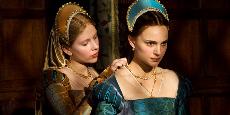
To a history and movie buff, there are two things that are hard to resist in life – Tudor history and Natalie Portman. Mesh the two, and it might as well be in heaven, but without a corset.
So naturally, one could imagine the delight upon hearing that Philippa Gregory’s 2002 bestseller, “The Other Boleyn Girl”, was being adapted for the big screen. Even more so, when word got around that BBC Films had drafted Portman to take on the title role of Anne Boleyn. It was a promise so good, there was swooning before the trailer was even released.
Two hours, stuck in the middle of some potentially silly, potentially arduous epic of a feature where copious amounts of horse-clomping and feigned dialects abound may not be everyone’s idea of a good time. Yet for those who are into that sort of thing, “The Other Boleyn Girl” rests at the nexus of some great expectations.
The bad news is it really doesn’t deliver.
For fellow fans of the subject matter, “The Other Boleyn Girl” corresponds with resurging interest in Tudor history. With everyone from Cate Blanchett to Showtime jumping on the Tudor bandwagon as of late, it’s a safe bet that we haven’t seen the last of these sixteenth century bed-hoppers outside of textbooks.
Yet for most, it’s the pairing of Portman and Scarlett Johansson that’s most worth buzzing about.
As the sisters Boleyn, the two share screen time as they vie for the affections of the indelible Henry VIII (Eric Bana). Under any other starlets, such a feat may sound like standard fare. But with Portman and Johansson at the helm, it’s a tantalizing cocktail of possibility. And what audience, hot for history or not, could claim immunity to such temptations?
The fun begins in a little manor home just north of obscurity. There, the Boleyn clan – an ambitious family of upstarts – bides time in preparation for more interesting times to come. Fate soon calls with a visit from rich relation, the Duke of Norfolk (David Morrissey).
Norfolk doesn’t take to posturing – he’s out trolling the countryside for cute girls to suit his hidden agenda. In the spirit of fatherly pimping, papa Boleyn (Mark Rylance) offers up his daughters – first cheeky Anne (Portman), then doe-eyed Mary (Johansson) – for the thankless task of playing bedfellow to the King of England.
Directed by Justin Chadwick, “The Other Boleyn Girl” boasts high production values and a sleek design. There’s also no denying the drama of the set up; the rise of Anne Boleyn from shire bumpkin to royal company ranks as one of the great cautionary tales of European history. Spun from the fresh perspective of Gregory’s novel and the possibilities seem almost endless. Yet still, the narrative stumbles.
For “Boleyn Girl”, the problem is as simple as its source material. Screenwriter Peter Morgan (“The Queen”) cuts state policy clean out, anteing up the drama by placing more emphasis on the bedchamber policy of his subjects.
The result: history as a high school soap opera.
Portman makes a great Anne Boleyn, though. Hollywood still gets it’s casting of the bad Queen all wrong, preferring pretty faces to powerhouses, but with Portman, it’s all relative. Unlike other Boleyns as portrayed by Genevieve Bujold (“Anne of the Thousand Days”) and Dorothy Tutin (“The Six Wives of Henry VIII”), she gets the dichotomy of her character. Neither total hussy nor scheming shrew, but never straying far from either stereotype, Portman’s performance is rich with complexity.
And Johansson isn’t bad either, although she’s sub to Portman for most of the picture. She’s better here than she’s been in her previous forays into period catastrophe – “The Black Dahlia” and “The Prestige” ranking among them. The role of placid Mary Boleyn suits her capabilities; emoting more through mannerism than bravado, the performance ranks reminiscent of some of her earlier gems.
Bana, however, fares less successfully. More stud horse than ogre of infamy, his Henry is a man removed from myth. Gone are the six wives and the Hans Holbein portraiture which would institute him perennially in the modern subconscious, and in its stead grows a fella whose desires often appear to transgress his more stately responsibilities as King.
For Henry, its girls first, politics later. The business of this kingdom is all about getting laid. Both the Break from Rome and the Declaration of Royal Supremacy come across as nothing more than afterthoughts in Henry’s pursuit of another piece of action. And sadly, that’s really all the plot amounts to.
Despite its best efforts, despite its sumptuous aesthetic and strong cast, the film isn’t strong enough to avoid the pitfalls that historical fictions are sometimes heir to. Under better circumstances, a story of this ilk would really shine. Instead, it bustles under its own weight, and what we’re left with barely measures up to the film’s total potential.
One day, the rise and fall of Anne Boleyn will receive the due storytelling it deserves. Until that time comes, repeated listenings of the Kingston Trio song “With Her Head Tucked Underneath Her Arm” would be more suitable than this lackluster endeavor.
Shayna Murphy can be reached at [email protected]






